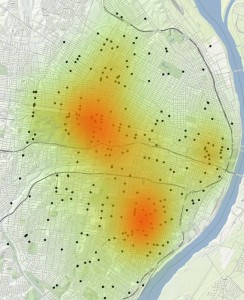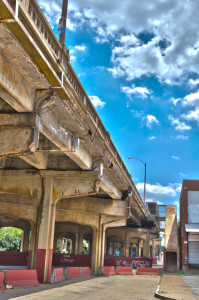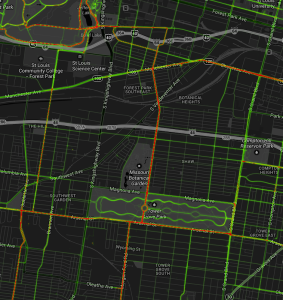It has been a month since cyclist Rick Beard – a veteran, entrepreneur, and father of three – was killed by a car while riding in St. Louis. The accident prompted debate and demonstrations, and has led to a push by cycling advocates for City policies to make St. Louis safer for cyclists and pedestrians. While the City has made real strides in the last several years, there is much that remains to be done.

Cyclists protesting for improved bicycle policies and infrastructure. St. Louis City Hall, June 30, 2014
Shortly after this tragedy several cyclists met with Mayor Slay’s staff and presented him with specific requests to make cycling safer. These include enforcement of a St. Louis City anti-harrassment ordinance as well as new laws, such as requiring 3-foot clearance when cars pass bikes. An ongoing dialog between the City and the cycling community is essential, and the authors suggest a city-wide web site devoted to cycling issues should be established to communicate with riders and solicit feedback. A new position of St. Louis Bike Safety and Transportation Coordinator would provide a point person for bike-related issues, and outreach to drivers and cyclists would educate both about rules of the road. The cycling advocates argue that complete and accessible reports of cycling collisions are necessary to provide data about problem hot spots, and better bike route connections together with traffic calming measures would help make roads safer for riders.

Map of St. Louis showing bicycle accidents (black dots) and dangerous areas (red colors). Such maps help planners and cyclists visualize problems and help target them efficiently. To be useful, such maps require accurate and timely reporting of accidents. Map courtesy Eliot Miller (see full version).
Others have shared additional ideas. Trailnet wrote a letter echoing similar themes, calling for a bicycle and pedestrian coordinator as well as new laws to ban texting while driving. Importantly, Trailnet asks the City to set a goal of zero bicycle and pedestrian fatalities by 2019. Such a proposal, similar to the successful Vision Zero initiatives in New York and San Francisco, is based on the idea that specific, measurable goals are necessary to drive improvement in the city’s pedestrian and bicycle environment. Today, traffic engineers designing roads are guided by numbers like automobile fatalities and traffic volume – shouldn’t measured bicycle safety also be a critical design consideration?

The Kingshighway Viaduct between Vandeventer and Shaw is in poor shape and will be torn down in Winter 2014/15. Closure of this major road will force traffic onto Tower Grove Avenue and make cycling more dangerous there.
There is no shortage of ideas for improving bicycle safety and conditions in St. Louis. While some officials in City government have shown real commitment to advancing cycling, significant sections of the city’s leadership continue to see riders as a marginal and irrelevant minority. The case of Tower Grove Avenue, the busiest cycling route in St. Louis, illustrates this point. The upcoming closure of the Kingshighway viaduct and the opening of I-64 ramps will send a flood of traffic along this critical bicycle connection and threaten its viability as a cycling route. Parts of Tower Grove Avenue are slated to get new lanes as part of the city-wide Bike St. Louis Phase 3 project, and such lanes will significantly improve cycling safety and accessibility. But it is not clear if these lanes will be installed before or after Kingshighway closes. When we spoke with him a year ago, Alderman Conway – who has a lot of control over such things – was completely opposed to installing any bike lanes on Tower Grove Ave before the Kingshighway bridge is rebuilt two or more years from now. He was clear: maximizing traffic flow is much more important than bike accessibility, and cyclists are a negligible constituency. (We’ll post updates if Alderman Conway’s view has changed since then.)

Map of St. Louis bicycle traffic volume, with red routes heavily traveled. Tower Grove Avenue stands out as a principal north/south St. Louis bicycle corridor. Map based on cyclist GPS data by Strava, the interactive version is very cool.
The uncertain fate of Tower Grove Avenue – a year from now, will it be a crowded two lane road bearing detour traffic or continue to flourish as a key cycling route? – encapsulates the challenges cycling advocates face in making St. Louis a better place to ride.
This is an important issue. Tower grove did not suffer much when grand was out, no? We need better data. How do rates of injury normalized to distance or time on the road compare among pedestrians, bikes, cars?